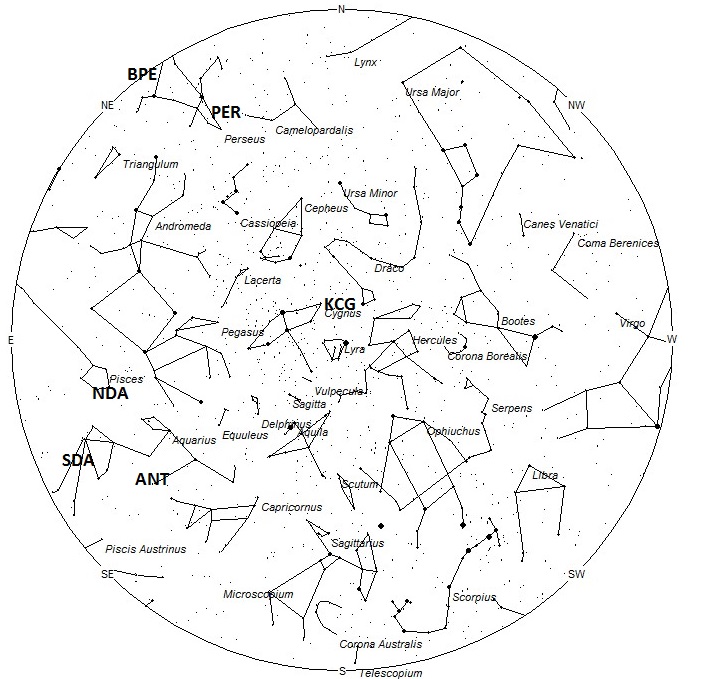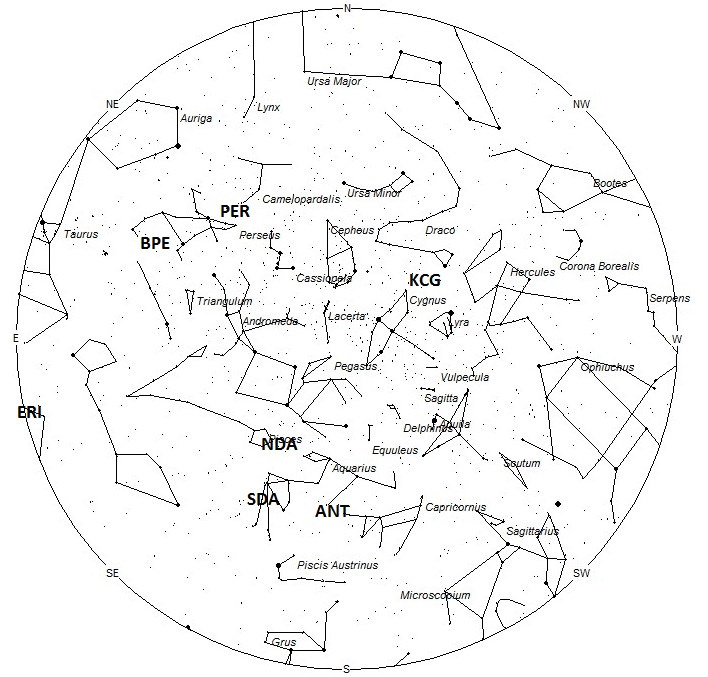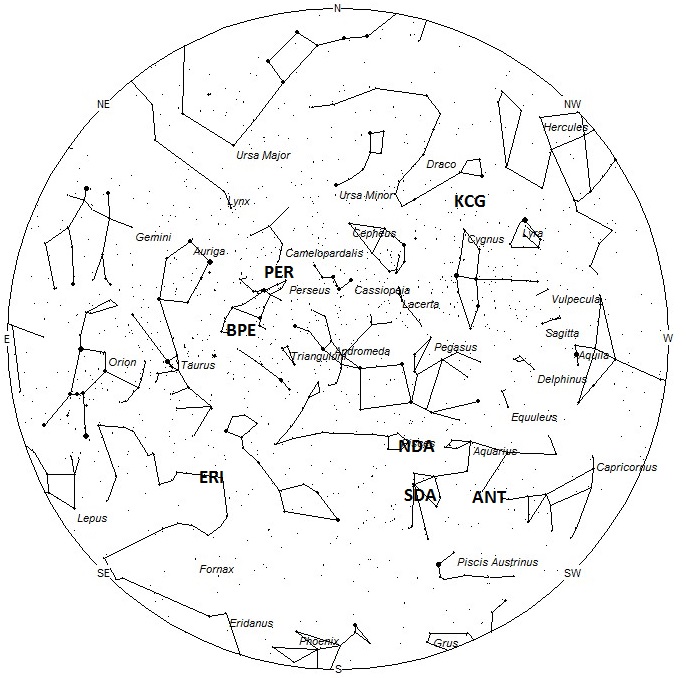During this period the moon reaches its full phase on Thursday August 18th. At this time the moon will lie opposite the sun and will lie above the horizon all night long. This weekend the waxing gibbous moon will set shortly before the start of dawn, obscuring many of the fainter meteors that would otherwise be seen in a darker sky . The estimated total hourly meteor rates for evening observers this week is near 3 for observers located in the northern hemisphere and 2 for observers located in tropical southern locations (25S). For morning observers the estimated total hourly rates should be near 40 for observers located in the northern hemisphere and 20 for observers located in tropical southern locations (25S). The actual rates will also depend on factors such as personal light and motion perception, local weather conditions, alertness and experience in watching meteor activity. Note that the hourly rates listed below are estimates as viewed from dark sky sites away from urban light sources. Observers viewing from urban areas will see less activity as only the brightest meteors will be visible from such locations. Rates during this period are reduced due to interfering moonlight.
The radiant (the area of the sky where meteors appear to shoot from) positions and rates listed below are exact for Saturday night/Sunday morning August 13/14. These positions do not change greatly day to day so the listed coordinates may be used during this entire period. Most star atlases (available at science stores and planetariums) will provide maps with grid lines of the celestial coordinates so that you may find out exactly where these positions are located in the sky. A planisphere or computer planetarium program is also useful in showing the sky at any time of night on any date of the year. Activity from each radiant is best seen when it is positioned highest in the sky, either due north or south along the meridian, depending on your latitude. It must be remembered that meteor activity is rarely seen at the radiant position. Rather they shoot outwards from the radiant so it is best to center your field of view so that the radiant lies at the edge and not the center. Viewing there will allow you to easily trace the path of each meteor back to the radiant (if it is a shower member) or in another direction if it is a sporadic. Meteor activity is not seen from radiants that are located far below the horizon. The positions below are listed in a west to east manner in order of right ascension (celestial longitude). The positions listed first are located further west therefore are accessible earlier in the night while those listed further down the list rise later in the night.
These sources of meteoric activity are expected to be active this week.
The Kappa Cygnids (KCG) are a conglomerate of at least 3 different radiants clustered in a large area of northwestern Cygnus and southern Draco. It would be very difficult for the visual observer to differentiate between these radiants so it is recommended that you simply label any meteor radiating from this area as a Kappa Cygnid. The center of this area is located near 18:20 (275) +55. This area of the sky is located in southern Draco, 5 degrees northeast of the 2nd magnitude star known as Eltanin (gamma Draconis). There is no sharp maximum for this shower, only a shallow slope that peaks near August 17th. These meteors are best seen as soon as it becomes dark in the evening hours. Current rates are expected to be near 2 per hour as seen from the northern hemisphere and less than 1 as seen from south of the equator. With an entry velocity of 19 km/sec., the average Kappa Cygnid meteor would be of slow velocity.
The center of the large Anthelion (ANT) radiant is currently located at 22:16 (334) -11. This position lies in west-central Aquarius, 1 degree northeast of the 4th magnitude star known as iota Aquarii. These meteors may be seen all night long but the radiant is best placed near 0200 LST when it lies on the meridian and is positioned highest in the sky. Due to the large radiant area, meteors from this source may also appear to radiant from the constellations of Piscis Austrinus and Capricornus as well as Aquarius. Rates at this time should be near 1 per hour as seen from the northern hemisphere and 2 per hour as seen from south of the equator. With an entry velocity of 30 km/sec., the average Anthelion meteor would be of slow velocity.
The North delta Aquariids (NDA) are active from August 7 through September 4, with the peak falling on August 19th. The radiant is currently located at 23:12 (348) +02. This area of the sky is located in western Pisces, just southwest of the 4th magnitude star known as gamma Piscium. The radiant is best placed near 0300 LST, when it lies highest in the sky. Current rates are expected to be near 1 per hour no matter your location. With an entry velocity of 39 km/sec., most activity from this radiant would be of average velocities.
The South delta Aquariids (SDA) are still active from a radiant located at 23:40 (355) -12. This position is located in central Aquarius, 3 degrees northwest of the 4th magnitude star known as omega2 Aquarii. Hourly rates this weekend will range from 1 per hour as seen from mid-northern latitudes to 2 per hour visible in southern tropical latitudes. The radiant rises near 2200 LST for observers located in the mid northern latitudes, but is best placed near 0300 LST, when it lies highest in the sky. With an entry velocity of 42 km/sec., most activity from this radiant would be of average velocities.
The eta Eridanids (ERI) were discovered by Japanese observers K. Ohtsuka, T. Tanigawa, H. Murayama, and I. Hasegawa. These meteors are active from July 31st through August 17th and may be responsible for many of the meteors reported from the Cetus/Eridanus area during the Perseid maximum. Maximum activity occurred on August 5th. The radiant is currently located at 03:08 (047) -09. This position lies in western Eridanus, 2 degrees east of the 4th magnitude star known as Azha (eta Eridani). The radiant is best placed during the last hour before the start of morning twilight when it lies highest in a dark sky. With an entry velocity of 66 km/sec., most activity from this radiant would be swift.
The Perseids (PER) peaked strongly on the morning of August 12th. They are still active from a radiant located at 03:24 (051) +58. This area of the sky lies in the southwestern Camelopardalis, 5 degrees northeast of the 4th magnitude star known as Miram (eta Persei). This area of the sky is best seen during the last dark hour before dawn when the radiant lies highest in a dark sky. Rates on Sunday morning as seen from the northern hemisphere after moonset are expected to be near 20 per hour. These rates will fall by 33%-50% with each passing morning. With an entry velocity of 61 km/sec., the average Perseid meteor would be of swift speed.
The beta Perseids (BPE) are active from July 24th through August 20th with maximum activity occurring on August 7th. The radiant is currently located at 03:24 (051) +36. This position lies in southern Perseus, 5 degrees southeast of the famous bright eclipsing variable star known as Algol (beta Persei). Current rates are expected to be near 1 per hour as seen from the northern hemisphere and less than 1 as seen from south of the equator. This radiant is fairly close to the far more powerful Perseids and one needs to look toward both radiants in order to properly separate the two sources. Those observers facing away from the constellation of Perseus will undoubtedly include these meteors in their Perseid totals. The radiant is best placed during the last hour before the start of morning twilight when it lies highest in a dark sky. With an entry velocity of 68 km/sec., most activity from this radiant would be swift.
As seen from the mid-northern hemisphere (45N) one would expect to see approximately 14 sporadic meteors per hour during the last hour before dawn as seen from rural observing sites. Evening rates would be near 2 per hour. As seen from the tropical southern latitudes (25S), morning rates would be near 9 per hour as seen from rural observing sites and 1 per hour during the evening hours. Locations between these two extremes would see activity between the listed figures.
The table below presents a list of radiants that are expected to be active this week. Rates and positions are exact for Saturday night/Sunday morning except where noted in the shower descriptions.
| SHOWER | DATE OF MAXIMUM ACTIVITY | CELESTIAL POSITION | ENTRY VELOCITY | CULMINATION | HOURLY RATE | CLASS |
|---|---|---|---|---|---|---|
| RA (RA in Deg.) DEC | Km/Sec | Local Summer Time | North-South | |||
| kappa Cygnids (KCG) | Aug 17 | 18:20 (275) +55 | 19 | 23:00 | 1 – <1 | II |
| Anthelions (ANT) | – | 22:16 (334) -11 | 29 | 02:00 | 1 – 2 | II |
| North delta Aquariids (NDA) | Aug 19 | 23:12 (348) +02 | 41 | 03:00 | 1 – 1 | IV |
| South delta Aquariids (SDA) | Jul 28 | 23:40 (355) -12 | 42 | 03:00 | 1 – 2 | I |
| eta Eridanids (ERI) | Aug 05 | 03:08 (047) -09 | 66 | 06:00 | 1 – 1 | IV |
| Perseids (PER) | Aug 12 | 03:24 (051) +58 | 61 | 06:00 | 20 – 5 | I |
| beta Perseids (BPE) | Aug 07 | 03:24 (051) +36 | 61 | 06:00 | 1 – <1 | IV |




